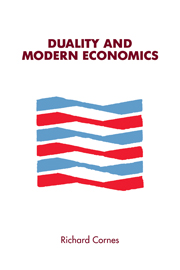Book contents
- Frontmatter
- Contents
- Preface
- PART I SOME BACKGROUND
- PART II MODELING INDIVIDUAL CONSUMER AND PRODUCER BEHAVIOR
- PART III APPLYING THE MODEL OF INDIVIDUAL BEHAVIOR
- Chapter 8 Aggregation analysis
- Chapter 9 Consumer theory and welfare evaluation
- Chapter 10 Externalities and public goods
- Epilogue
- Bibliography
- Author index
- Subject index
Chapter 10 - Externalities and public goods
Published online by Cambridge University Press: 11 September 2009
- Frontmatter
- Contents
- Preface
- PART I SOME BACKGROUND
- PART II MODELING INDIVIDUAL CONSUMER AND PRODUCER BEHAVIOR
- PART III APPLYING THE MODEL OF INDIVIDUAL BEHAVIOR
- Chapter 8 Aggregation analysis
- Chapter 9 Consumer theory and welfare evaluation
- Chapter 10 Externalities and public goods
- Epilogue
- Bibliography
- Author index
- Subject index
Summary
I asserted in Chapter 7 that externalities and public goods can usefully be modeled as quantity constraints. The restricted indirect utility and expenditure functions can then be used, together with the implied demand and inverse demand functions, to analyze the comparative static and optimality properties of equilibrium. Much of the literature on externalities has been concerned with the idea that in their presence, a decentralized market equilibrium may fail to attain a Pareto optimum. The Pigouvian tradition has gone on to explore the possibility of finding a set of taxes and subsidies that will sustain a Pareto-optimal equilibrium. In general, there is no presumption that an arbitrary Pareto optimum will be Pareto-superior to a given equilibrium established in the absence of taxes. It is of interest to explore the possibility of Pareto-improving moves from an equilibrium – that is, moves that make no individual worse off and that make at least one individual better off than at an initial equilibrium. It turns out that in many situations Pigouvian taxes and subsidies are not enough to secure a Rareto improvement. They must be supplemented by some means, whether lump-sum or distortionary, of redistributing real income. A further concern of students of externalities has been the possibility that in the move from an equilibrium to an optimal allocation, the level of activities associated with detrimental externalities, such as air pollution, may rise. Conversely, the level of those activities that generate beneficial externalities may fall.
- Type
- Chapter
- Information
- Duality and Modern Economics , pp. 236 - 262Publisher: Cambridge University PressPrint publication year: 1992



